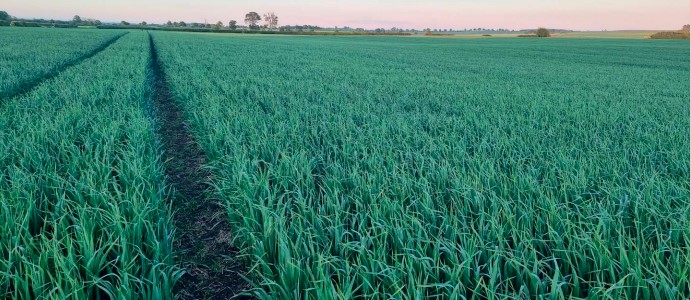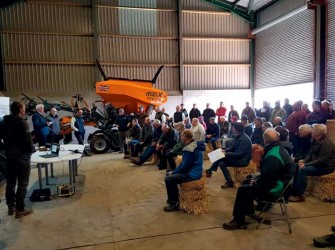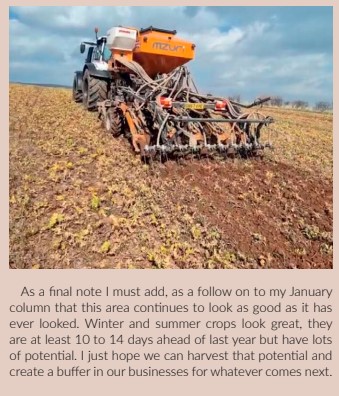
As I write I am sure we are all looking forward to Groundswell, getting off the farm is an important thing for many reasons. I still tell people about last years’ experience and how much I learnt.

What a time to be a farmer, who could have predicted the chain of events leading up to this point, and I can’t see anybody being able to confidently predict the next 12 days never mind 12 months!? Events have brought production costs and margins into sharp focus and the increased cost for many systems will be prohibitive. Its times like this I’m glad I looked at and started down a direct drilling route. Cutting out any prior cultivation means that although my Mzuri does move some soil and create tilth it establishes crops on my ground as efficiently as possible. I do still plough around 10% of my ground after drainage work or potatoes but that is also sown mostly with the Mzuri as this allows variable seed rate and placed fertiliser at sowing. I am up to 90% direct drilled now as the two systems, plough/power harrow drill and direct drill, run together for years were producing similar yields at very different margins.
This year I tried a winter cover crop consisting of Phacelia, farm saved beans and buckwheat. I looked at various mixes but following lots of American research, went for a simple 3-way mix. The research shows that below ground a 3-way mix can add as much as any larger mix and I was able to cheapen it further by using farm saved spring beans. This mix was sown Sep 3rd at 12kph one pass after the previous wheat crop was removed. In Scotland we are usually waiting for ground to dry enough so we can get on sowing, so an open cover was essential. The cover got a great start and finally the frost killed the buckwheat around Dec 1st, the cold also checked the beans enough to keep them manageable, the roots had lots of nodules, so job done.
Everything was then sprayed off, hen muck spread, and then Canyon oats for Quaker sown variable rate into the cover. We had a dry spell after sowing and while the oats emerged well, they maybe didn’t tiller quite as much as usual, I don’t know if this was just the dry or maybe something from the cover, but the ground conditions at sowing were ideal. The roots of the cover had kept the soil moist and loose, and the worm action made it appear like a grow bag mix. I only added 60kg of bagged N and today they look good. If the yield is good, it is something I will try again but maybe with a further reduction in applied N.

I did a few contract jobs for this harvest. Two of them were wheat direct into grass leys and then an interesting trial involving the Hutton institute. The trial, sown in April, was for a poultry farmer who is looking to grow home grown proteins in the mix making up his ration. This will be cut in one go with his combine. First sowing pass, beans 3 inches deep, and either side out the coulter 1-inch-deep spring wheat. 2nd pass I nudged the GPS between the rows and at 1.5inches deep the peas and either side 1inch deep, Lupins. No peas on the tramlines, then plots of each individual crop. It got off to a difficult start capping a little in some wet then very dry weather, but I think this will be very interesting to see how it develops, I must admit combining it could be the real challenge.
Back at home I held an open day on behalf of NFUS and it turned out to be a big success. We had 60 people in the shed and field walk, all looking at my system and crops. I think we were all ready to come out and kick some tyres again. Some good questions, from glyphosate use to mistakes I’ve made in the past. I do wish I had taken photos of the terrible spring barley or osr that I had at the beginning. At the time I was just glad to learn and move on, not expecting to be telling others about it later. There is a huge interest in reduced tillage, and this magazine, I think Groundswell and honest feedback has helped me a lot, my concern is the Scottish government, and many others are becoming experts on what is best for my farm. Knowledge transfer must be run with a farmer-to-farmer focus, not just ‘experts’ or industry advisors at inflated prices.
I still don’t believe we have a reliable and standard way to measure farming’s carbon footprint, but we are pushing on with grants, audits and soil testing not knowing ultimately what they hope to achieve! We face a dwindling choice of chemicals; I am practicing reduced use and IPM but a lack of choice usually compromises the effectiveness of a spray program. Like the improvements I have made on my farm, success comes through a combination of many methods, plant breeding, new chemistry, soil health, knowledge and tech must all be invested in and properly explored to maximise output on reduced inputs thus reducing our environmental footprint.
